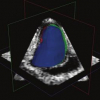Free Online Productivity Tools
i2Speak
i2Symbol
i2OCR
iTex2Img
iWeb2Print
iWeb2Shot
i2Type
iPdf2Split
iPdf2Merge
i2Bopomofo
i2Arabic
i2Style
i2Image
i2PDF
iLatex2Rtf
Sci2ools
ISBI
2008
IEEE
2008
IEEE
Real-time segmentation of 4D ultrasound by Active Geometric Functions
Four-dimensional ultrasound based on matrix phased array transducers can capture the complex 4D cardiac motion in a complete and real-time fashion. However, the large amount of information residing in 4D ultrasound scans and novel applications under interventional settings pose a big challenge in efficiency for workflow and computer-aided diagnostic algorithms such as segmentation. In this context, a novel formulation framework of the minimal surface problem, called Active Geometric Functions (AGF), is proposed to reach truly real-time performance in segmenting 4D ultrasound data. A specific instance of AGF based on finite element modeling and Hermite surface descriptors was implemented and evaluated on 35 4D ultrasound data sets with a total of 425 time frames. Quantitative comparison to manual tracing showed that the proposed method provides LV contours close to manual segmentation and that the discrepancy was comparable to inter-observer tracing variability. The ability of such rea...
| Added | 20 Nov 2009 |
| Updated | 20 Nov 2009 |
| Type | Conference |
| Year | 2008 |
| Where | ISBI |
| Authors | Qi Duan, Elsa D. Angelini, Shunichi Homma, Andrew F. Laine |
Comments (0)

